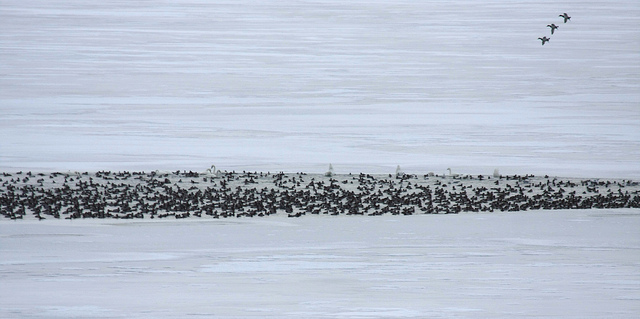
The French supply ship L’Astrolabe taking a ‘break’ in sea ice en route from Hobart to the French Antarctic base, Dumont D’Urville. Credit: Dale Kolody
By Craig Macaulay
When you rely on shipping in the polar regions as a platform to conduct scientific research the extent of sea ice is very much a consideration in planning.
Sea ice has been a big issue this season for the French Antarctic re-supply vessel, the 65-metre L’Astrolabe, and it has been well and truly on the radar of CSIRO project leaders who have collaborative research programs on the ship with their French colleagues. Because the vessel operates along the same route between Hobart and the French Antarctic base of Dumont D’Urville, L’Astrolabe is attractive as a platform for science during its four return voyages each season.
The voyages allow French and Australian researchers to make clear comparisons on water properties through the spring-summer supply months during what has been a very successful and long-running collaborative program, supported in recent years through Australia’s Integrated Marine Observing System.
The journey from Hobart to Dumont D’Urville takes six days, presuming there is little sea ice along the route. The challenge for the ship’s Master is always to find a lead through the sea ice circling the continent, to reach the base.
Throughout this season the ship has encountered heavy ice in East Antarctica, and on January 23 the decision was made to halt science programs because of the ongoing disruption to the ship’s schedule.
Similar conditions will face the larger New Zealand vessel Tangaroa, which leaves Wellington on February 2 carrying three deep ocean moorings intended for deployment in the Mertz Polynya region.
Built by engineering staff at CSIRO’s Hobart Marine Laboratories in 2012, the moorings were shipped to New Zealand before Christmas for loading on the Tangaroa, in voyage, that will be carrying 22 Australian, New Zealand and French on a 42-day voyage to the Mertz Polynya region, one of a few places in the world where the densest ocean waters form.
Among staff from CSIRO will be Beatriz Pena-Molino, Peter Hughes, Kate Berry , Sue Reynolds and CSIRO-Utas student, Eva Cougnon. Elizabeth Shadwick and Mark Rosenberg from the Antarctic Climate & Ecosystem CRC also will support the voyage science.

A polynya. Image: Flickr / Seabamirum
A polynya is an area of open water surrounded by sea ice. Polynyas are kept free of sea ice by the wind, which constantly blows away any ice that tries to form. The formation of sea ice creates heavier saltier water, which then sinks and spreads to fill the bottom of the global ocean. This means it has a significant influence on global ocean circulation.

Steve Rintoul with one of the $100,000 deep ocean moorings that will be deployed in polar waters.
In 2010, the tongue of Antarctica’s Mertz Glacier was rammed by a huge iceberg, causing much of the tongue to break away. Scientists want to study the impact of this massive change to the Mertz Glacier on the surrounding environment.
This region is one of three unique places around Antarctica which control the properties of the deep ocean – thus the breaking ice tongue could have wider impacts on global ocean circulation. To study the changes in the ocean, the scientists will use a suite of underwater cameras, moorings and sensors.
Hobart’s Steve Rintoul is the leader of the Australian team on the Tangaroa voyage.
“When we speak of global warming, we really mean ocean warming: more than 90% of the extra heat energy stored by the earth over the last 50 years has gone into warming up the ocean. The Southern Ocean is particularly important because it stores more heat and carbon dioxide released by human activities than any other region, and so helps to slow the rate of climate change.
“Our earlier research in this region has shown that rapid changes are underway in the deep ocean, but we are not yet sure what is driving the changes. The measurements collected on the Tangaroa voyage will be used to test the hypothesis that increased melt of Antarctic ice is driving changes we see in the deep ocean,” Dr Rintoul said.
But first they have to get there.
Aurora Australis has been the platform for much of Australia’s Southern Ocean marine science programs. The Australian Government is taking the first steps towards replacing the ship that has been supporting Antarctic and Southern Ocean programs for 23 years.
In February 2012, Steve Rintoul was interviewed by colleague Nick Roden aboard Aurora Australis and discussed the many and varied aspects of Southern Ocean research:

